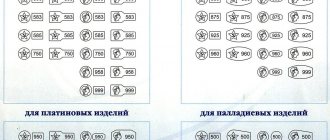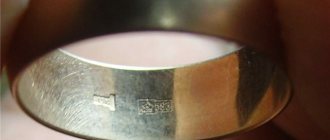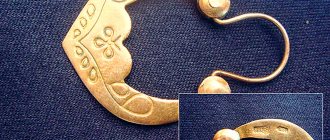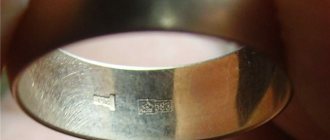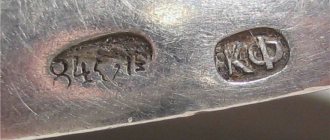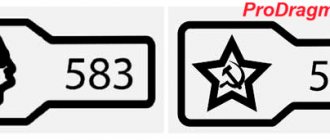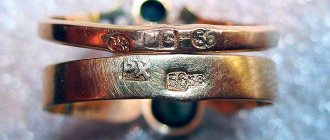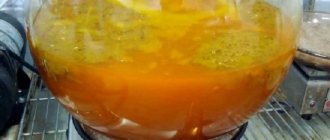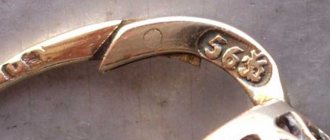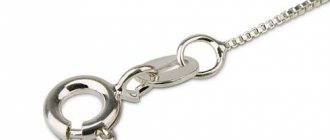Try asking your child what a tear is. Most likely, you will find out that “a tear is just when we cry.” Meanwhile, not every adult knows: a tear is far from “simple” and, in addition, tears are always present in the eyes, and not just when crying.
The human lacrimal apparatus is a tiny irrigation and drainage system. In a very limited volume near the front of the eyeball, tear fluid must somehow be produced, perform its functions and be discharged along certain drainage paths. Let's try to figure out how this happens.
History of branding
Assay supervision was established in Russia back in the 17th century. Testing and branding were carried out in the Serebrenny Row in Moscow. This was the only place where precious metals could be legally sold. Now not only jewelry, but also any items made of precious metals are subject to branding. In the Assay Office, in addition to applying a mark to the product, examination of impressions, technical examination, as well as control analyzes of alloys and precious stones are carried out.
The first stamp dates back to 1651-1652 and has an image of a double-headed eagle and the date of manufacture. At first, the stamps did not display alloy quality marks, but such stamps were placed only on products with a spool sample of 83 and above. Imported coins, melted down for jewelry, had exactly this standard.
The spool sampling system existed in Russia before the introduction of the modern one. It was based on the concept of the Russian pound, which was equal to 0.4 kg and contained 96 spools. Thus, a product made of pure gold had a purity of 96, and a purity of 48 was only half made of gold.
Stamp "sample"
As described earlier, such marks began to be used for the first time in the 19th century. Since then they have not changed much and remain in the same place on the product. The shape and size of such an assay mark depends on the state standards of the country of origin. Officially, it is called the “stamp of the state assay inspection.” In the Russian Federation, the sale of products without such a stamp is prohibited.
The gold stamp in the Russian Federation consists of several parts:
- the shape of the mark itself;
- the head of a girl in a kokoshnik looking to the right;
- Assay inspection code;
- sample of the product according to the standard.
Stamp structure
The Assay Inspection Code indicates where the product was tested. The shape or contour of the mark itself indicates the type of precious metal. The outline on a gold product resembles the appearance of a spatula; silver products are branded with an oval cut off on both sides. The outline of the platinum mark looks like an elongated octagon.
On older items you will find a star stamp. Thus, according to the standard, products were branded in the USSR. But the contours should correspond to modern ones - they have not been changed since then.
Jewelry can be hallmarked only by specialists from the Assay Supervision Chamber. Jewelers can also hallmark their pieces, but to a different standard. Imprints made by jewelers are called “name stamps”. The name tag does not indicate the quality of the metal, but is a kind of signature of the manufacturing company or craftsman. For most buyers, such a sign means nothing.
If you purchase a product made in another state on the territory of the Russian Federation, then the hallmark must still be present on it. Thus, a foreign-made product may have several imprints. In Western countries, products have slightly different samples - they are called “karats”.
The karat system is simple - it shows how many parts of pure gold are in a 24-carat item. That is, a pure gold item would have a 24-karat purity. It is easy to calculate the correspondence with the Russian standard - 375 will be equal to 9 carats, and 585 will correspond to 14 carats.
Lesson "Spark test for metal identification."
Insert
Spark test for metal identification
Steel grades used for the manufacture of keys: St 20 and St45
Often in production or in everyday life it is necessary to install a key with specified properties (for example, a safety key or, on the contrary, to transmit large torque). But unfortunately, a device for determining the composition of a material is very expensive (about 100,000 euros), and access to it is quite difficult. Observant craftsmen have noticed that metals of different chemical compositions are also separated by physical properties. This is how several methods have emerged for approximate determination of steel grade. Using one of them, you can determine three gradations of grade: low-hardness steels (low-carbon) can be filed with any file, including garnish; medium hardness - only personal and velvet; high hardness - only velvet.
In the USSR, everyone knew that nails were made from St3, bolts and nuts were made from St35, and springs from St50-55
And another method is based on the fact that when processing samples on an emery wheel, each sample (brand) produces a specific beam of sparks. This method, with a little skill, allows you to identify brands with relatively high accuracy.
Now we’ll talk about it in more detail...
The spark test is designed to determine the grade of steel (1. structural ordinary quality, 2. structural high-quality or 3. high-speed). The belonging of steel to a certain grade is determined quite accurately using this method.
I have collected for you all the latest information on this issue. When there were few alloys on the market, the spark test was a quick and accurate way to identify iron and major steels. Now, with hundreds of alloys used for tools, this technique is much less reliable, but can still be used for rough classification in many cases.
And it still remains an effective way to determine the alloy for the key we need. The spark patterns shown are representative of what should be obtained when sampling on a mechanical dry grinding wheel.
Wrought iron.
Long yellow lines that become leaf-shaped before fading.
Mild steel.
Greater variety in stroke length, with quick decay and some sparkle.
Medium carbon steel.
Almost no leaves, some branching, more variety in the length of the strokes, sparkling closer to the circle.
High carbon steel
. There are no leaves, a dense spark pattern, branching and sparking begins almost right next to the circle; less bright than medium carbon steel.
Manganese steel.
Small leaves form sparks before the dashes.
To eliminate iron oxides that form during the production of cast steel, a certain amount of manganese is usually introduced into the liquid metal, in the form of mirror cast iron or ferromanganese. Part of the manganese in mirror cast iron deoxidizes the oxides and turns into slag, while part remains in the steel in the form of a compound with iron or simply as a mechanical impurity. Thus, steel always contains some manganese. In general, manganese increases hardness, increases elastic limit and tensile strength, and also strengthens steel. In low-carbon steels, the admixture of manganese even increases the viscosity of the metal, but with a significant carbon content, manganese makes it brittle.
High speed steel.
Faint red lines branching at the end
From the history.
For turning parts made of wood, non-ferrous metals, and mild steel, cutters made of ordinary hard steel were quite suitable, but when processing steel parts, the cutter quickly heated up, soon wore out, and the part could not be turned at a speed of more than 5 m/min [1].
This barrier was overcome after R. Muschette produced steel containing 1.85% carbon, 9% tungsten and 2.5% manganese in 1858. Ten years later, Muschette made a new steel, called self-heating steel. It contained 2.15% carbon, 0.38% manganese, 5.44% tungsten and 0.4% chromium. Three years later, production of muschette steel began at Samuel Osburn's Sheffield plant. It did not lose its cutting ability when heated to 300 °C and made it possible to increase the metal cutting speed by one and a half times - 7.5 m/min.
Forty years later, high-speed steel from American engineers Taylor and Watt appeared on the market. Cutters made of this steel allowed cutting speeds of up to 18 m/min. This steel became the prototype of modern high-speed steel R18.
After another 5-6 years, ultra-high-speed steel appeared, allowing cutting speeds of up to 35 m/min. Thus, thanks to tungsten, a sevenfold increase in cutting speed was achieved over 50 years and, consequently, the productivity of metal-cutting machines increased by the same amount.
Further successful use of tungsten found application in the creation of hard alloys, which consist of tungsten, chromium, and cobalt. Alloys for cutters such as stellite were created. The first stellite made it possible to increase the cutting speed to 45 m/min at a temperature of 700–750 °C. The alloy of this type, released by Krupp in 1927, had a Mohs hardness of 9.7-9.9 (the hardness of diamond is 10).
In the 1970s, due to a shortage of tungsten, high-speed steel grade R18 was almost universally replaced by steel grade R6M5 (the so-called “samokal”, self-hardening steel), which, in turn, was replaced by tungsten-free R0M5F1 and R0M2F3.
Stainless steel
. Bright yellow lines with small leaves at the end
Now I will show you a collection of sparks in the form of pictures of some steels:
Stamp "name"
The manufacturer's name is an additional mark that is installed on the jewelry. If you decrypt it, you will receive additional information about the product you purchased.
This mark contains 4 letters - this is a code. Its contours are rectangular in shape and it is applied close to the assay mark. The first letter of the imprint indicates the year in which the product was produced. The letter “A” corresponds to the year 2001, the letter “B” to 2002, and so on.
Sample location on the product
The second letter indicates the place where the product was tested. It must correspond to the one on the hallmark. The last two letters indicate the manufacturer, they are unique within one inspection.
Methods of applying stamps
Jewelry is branded in three main ways: using a laser, mechanically and electrospark method. The method is selected depending on the size and price of the finished product. This is done so that elegant and small products are not spoiled by sloppy printing. Therefore, these methods are developed and improved over time. Each of them has a number of advantages and disadvantages.
- The mechanical method is considered the roughest. Impressions are made with special tools - jackhammers. In this case, the product is firmly fixed in a vice. This method is the oldest and most durable; it has been known since the 17th century. It does not spoil the appearance of the product, which is why it is used in more than 80% of cases. Now this method is automated, and jewelry is branded on an assembly line.
- In some cases, there is still a risk of scratches and deformation, then a more accurate type of marking for a particular product is chosen - the electric spark method is one of them. In this case, the print is made by burning the design using sparks. This application will last a long time even on thin items. The mark is applied using this method only on a flat surface. This method is more modern, it is about 50 years old.
- The most difficult and costly is the branding of jewelry using a laser machine. The impression is durable and invisible. However, the laser performance is low. There is another advantage of the laser - the brand can be convex. Such a mark is not applied to places that are constantly in contact with the skin: on the inside of the ring it can be erased even in less than 5 years.
Thus, the method of applying a brand is selected taking into account all the advantages and disadvantages of a particular method. In some cases, the control chamber may agree with the manufacturer on the methodology used. This is especially true for products with large expensive stones and elegant contours. It is very important not to spoil their appearance so that the product does not lose its value.
A product without a stamp is a fake; such a product is not valued and cannot be sold or pawned. Always before purchasing expensive jewelry, inquire about its origin and carefully examine the sample. Selling jewelry without a hallmark is a violation of existing laws for the sale of products made of precious metals.
Forging a stamp on gold is not easy and not everyone will do it, as it is a very risky activity. Most often, a higher standard is set, which does not correspond to the quality of the product. Such products are mainly sold in small stores and online. Very rarely do they end up in decent retail outlets. It is almost impossible to identify a well-made fake by eye; jewelers use a special touchstone for this. Therefore, carefully study the brand before purchasing - it must have clear, even contours, all parts of the code must be made with high quality and be easy to read.
Anatomical sections of the lacrimal apparatus and clinical methods for assessing their functional state
There are two main structural elements: tear producing and tear draining. From school we remember that “tears are produced by the lacrimal gland,” but this knowledge is incomplete and insufficient. The fact is that the composition of the tear fluid is very complex and must be clearly balanced, since it performs a number of difficult-to-combine functions simultaneously: wetting the anterior surface of the eyeball (which is especially important for the transparent cornea, which would otherwise dangerously dry out when interacting with air oxygen), aseptic removing trapped particles, minimizing friction during movements of the eyeball and, at the same time, protecting tissues from waterlogging and “souring.”
Therefore, the composition of tears includes not only the liquid fractions themselves, but also oily-mucous, hydrophobic ones, and separate structural parts of the tear-producing section are responsible for their secretion. In addition to the main lacrimal gland, located above the eye from the side of the temple, there are also additional lipid and mucin glands of the conjunctiva, the mouths of which extend onto the inner surface of the eyelids adjacent to the eye.
Mixing and uniform distribution of various fractions of tear fluid over the surface of the eyeball occurs when blinking, ensuring constant renewal of a thin, but multi-layered tear film, which protects the cornea, sclera, and conjunctiva from the problems described above. Considering the mobility of the eyeball and the unreliability of surface tension, the film must be renewed quite often: otherwise, tears will appear in it (the fabric dries faster in these areas) and, in addition, the film itself quickly evaporates. Therefore, you should not suppress the natural blink reflex and read these lines, as they say, with an unblinking gaze - it is no coincidence that any system of eye gymnastics for people who constantly work with a computer necessarily includes breaks with intense blinking.
Having given way to a new portion, the waste tear fluid must, of course, go somewhere, otherwise the person would cry for days on end. On the inner wall of the eyelid, at the bridge of the nose, there are drainage entrances to the lacrimal canaliculi, where excess moisture flows. Getting into the so-called lacrimal sac, through the nasolacrimal duct, the liquid is discharged into the nasal cavity, where it is used for additional wetting of the nasal mucosa.
